Tight or Loose: Analysis of the Organization Cognition Process of Epidemic Risk and Policy Selection
Abstract
1. Introduction
2. Literature Review
2.1. Research on Public Policy Choice
- In terms of the participants of policy choice, it has become a consensus that multi-agent participation supports the rationality of policy choice, and active participation incentive and function matching as well as participants’ risk perception ability and knowledge level have positive effects on multi-participation [7,8,9];
- In terms of the basis for policy selection, the determination of epidemic prevention policies not only relies on sufficient and abundant relevant information but also depends on the characteristics of policy objects, the background of policy implementation, and the support of various regulatory mechanisms [10,11,12];
- In terms of the process of policy selection, the general process mainly includes environment and object evaluation, system cost evaluation, and policy tool simulation, among which the opening and evolution of the policy selection process are not only affected by object positioning but also by stakeholders [13,14,15];
- In terms of tools for policy choice, scholars have conducted objective and specific discussions on such policy choice tools such as information tools, technology tools, and regulation tools based on specific cases, including not only the tool choice mode of m/n but also the tool combination mode of Cnm [16,17,18].
2.2. Research on Organizational Cognition
3. Epidemic Prevention Policy Selection in the Evolution of Organizational Cognition
3.1. Research Design
3.1.1. Fusion of Methods
- Time series analysis (TSA) decomposes an event into trend, cycle, period, and unstable factors. It emphasizes the extraction of relevant event features and the analysis of its change process and development mode through continuous observation of a region within a certain period of time [34].
- Cross-case comparative analysis (CCA) would be used to explore the common factors and individual factors in epidemic risk organizational cognition by sorting out the homogeneous elements and the heterogeneous elements in different cases [35].
3.1.2. Case Selection
3.2. Selection Process of Epidemic Risk Prevention Policy
3.3. Stage Division of Epidemic Risk Organizational Cognition
- Red Curve: Discontinuity point (a) comes from the government’s advocacy for residents to maintain good health habits in public places, which belongs to the guiding policy; discontinuity point (b) is derived from the formal definition of the human-to-human transmission characteristics of COVID-19, which is manifested as the implementation of a Lockdown in Wuhan; discontinuity point (c) stems from the initial solution of the early epidemic and the “lifting of the lockdown” strategy, but it still maintains a policy tightening far beyond that before the outbreak of the epidemic.
- Blue Curve: Discontinuity point (a) comes from a series of closed control measures according to the emergency plan because of the fact that the key units were affected by the imported epidemic; discontinuity points (b,c) originated from the Static Management in Shanghai after the sharp increase in the number of infections and deaths, which has the hierarchical and classified attributes; discontinuity points (d,e,f) come from the step-by-step lifting of the Static Management, but in order to continue to control the epidemic risk, the policy tightness remains at a relatively high position.
- Green Curve: discontinuity point (a) originated from the quickly implemented risk hierarchical control and dynamic zero clearance strategy for responding to the winter epidemic on the Chinese mainland in 2022, so the curve after the discontinuity point is slightly lower than that of the first two cases; discontinuity point (b) originated from the Category B and B control policies issued by the National Health Commission. Because the epidemic situation and virus characteristics at that time were comprehensively analyzed and judged, the intensity of the new mutant virus dropped significantly [38].
- In the fuzzy cognition stage, for the new epidemic, the cognition level is positively correlated with the time course. However, due to the lack of control over the epidemic situation and virus information, the slope of the curve is small. For the late-onset epidemic, due to changes in the background such as virus mutation, social and economic impact, and the resilience of disaster-bearing bodies, the cognition of epidemic risk organizations shows a certain degree of inadaptation [39], so the cognition curve decreases.
- In the key cognition stage, with the progress of the epidemic in Wuhan and Shanghai and the enrichment of relevant information, organizational cognition on the risk of the epidemic began to evolve, which was reflected in the improvement of the slope of the cognition curve, that is, the curve had an inflection point.
- In the stage of deepening cognition, since the change in the direction of policy choice in the winter of 2022 is an innovation, it takes a longer and more stable time to analyze the risk situation of the epidemic. Therefore, the inflection points in the third case occurred at the stage of deepening cognition. The overall cognitive performance of the epidemic prevention model in the latter two cases was gradually internalized as part of the organizational culture.
4. Organizational Cognition Nodes of Epidemic Risk Based on the Knowledge—Cognition Dimension
4.1. Organizational Cognition Process of Epidemic Risk
4.1.1. Dimensions of Cognition and Knowledge
4.1.2. Organizational Cognitive Spiral Balanced by Knowledge and Cognition
4.2. Key Nodes in the Organization Cognition Process of Epidemic Risk
- Cognitive initiation node: The risk preference, personal characteristics, and professional ability of the management will dominate the cognitive priming. The overall risk cognition level and execution ability of grass-roots members determine the realization of organizational risk management performance. The relationship attributes, process mechanism, and resource matching of organizational operations restrict the initiation efficiency of organizational cognition. In Case <1>, organizational cognition initiation comes from the normal epidemic risk monitoring and reporting mechanism. The existing organizational culture rich in awareness of innovation, risk, and development is not only reflected in explicit rules and regulations (such as the emergency plan launched in Case <2>) but also in the implicit organizational atmosphere (such as the precipitation of the concept of precise epidemic prevention in each organization in Case <3>). The stimulation of external factors is reflected in the following two aspects: the organizational needs are internalized in the operation of the organization, and the organization tracks and evaluates the changes in various social and economic fields based on the policy goals and guides the cognitive direction. For example, in Case <1>, the government started the organizational cognitive upgrading in response to the unknown pneumonia epidemic.
- Cognitive development node: Cognitive development nodes come from the intersection of the organizational cognitive spiral and cognitive breadth and depth. When organizations perceive epidemic risk information for the first time, they should first make clear what knowledge and information they should master, that is, come to the node of cognitive breadth. In Case <1>, before upgrading organizational cognition, governments first mastered the necessary knowledge and skills, such as risk source information, virus information, and transmission path, etc. The next step is to explore the essential characteristics and development rules of epidemic risk based on extensive cognition, that is, to come to the node of cognition depth. After the epidemic risk is monitored, the cognitive scope is further expanded through in-depth understanding, and then it enters a virtuous cycle of continuous improvement in the breadth and depth of cognition.
- Cognitive evolution node: The evolution of organizational cognition is reflected in the global changes within the organization affected by various factors, including institutional innovation and technological innovation. In epidemic risk perception, there is an interaction between various factors such as the organizational system, culture, and background. Organizations constantly assimilate external information into their own cognitive structure and constantly change their cognitive structure to adapt to the external environment. Among them, technological tool innovation is not only the result of cognitive evolution but also the support of institutional improvement, such as the makeshift hospital and health code technology in Case <1> and AI technology in Case <2>.
- Cognitive retroaction node: the cognitive retroaction node comes from the intersection of the organizational cognitive spiral curve and the knowledge externalization axis. As part of the dynamic cognitive system, feedback can not only reduce the cognitive differences within and outside the organization through practical interaction but also provide experiences or lessons for improving cognition. At the same time, feedback can also make the organization more active in understanding the required content, what good performance is, and the effort required to achieve the corresponding standard.
5. Key Points Selection of Epidemic Risk Prevention Policy Based on Organizational Cognition
5.1. Interaction between Organizational Cognition and Policy Choice
5.2. Key Points of Policy Selection for Epidemic Risk Prevention
6. Results
7. Discussion
8. Conclusions
Author Contributions
Funding
Institutional Review Board Statement
Informed Consent Statement
Data Availability Statement
Acknowledgments
Conflicts of Interest
References
- Yang, S.; Zhang, L.; Wang, L. Key factors of sustainable development of organization: Bibliometric analysis of organizational citizenship Behavior. Sustainability 2023, 10, 8261. [Google Scholar] [CrossRef]
- WHO Director-General’s Speech at the World Governments Summit—12 February 2024. Available online: https://www.who.int/director-general/speeches/detail/who-director-general-s-speech-at-the-world-governments-summit—12-february-2024 (accessed on 12 February 2024).
- Van Kerkhove, M.D.; Ryan, M.J.; Ghebreyesus, T.A. Preparing for “Disease X”. Science 2021, 6566, 377. [Google Scholar] [CrossRef] [PubMed]
- Mei, C.Q. Policy style, consistency and the effectiveness of the policy mix in China’s fight against COVID-19. Policy Soc. 2020, 3, 309–325. [Google Scholar] [CrossRef] [PubMed]
- Toader, A.F.; Martin, R. Bringing the cognitive revolution forward: What can team cognition contribute to our understanding of leadership? Leadersh. Q. 2023, 1, 101619. [Google Scholar] [CrossRef]
- Jenkins, W.I. Policy Analysis: A Political and Organizational Perspective; Martin Robertson: London, UK, 1978. [Google Scholar]
- Awaga, A.L.; Xu, W.; Liu, L.; Zhang, Y. Evolutionary game of green manufacturing mode of enterprises under the influence of government reward and punishment. Adv. Prod. Eng. Manag. 2020, 4, 416–430. [Google Scholar] [CrossRef]
- Tontrup, S.; Sprigman, C.J. Self-nudging contracts and the positive effects of autonomy-Analyzing the prospect of behavioral self-management. J. Empir. Leg. Stud. 2022, 3, 594–676. [Google Scholar] [CrossRef]
- Guntermann, E.; Lenz, G. Still not important enough? COVID-19 policy views and vote choice. Perspect. Polit. 2022, 2, 547–561. [Google Scholar] [CrossRef]
- Chen, J.G.; Smith, D. Disclosure policy choice, stock returns and information asymmetry: Evidence from capital expenditure announcements. Aust. J. Manag. 2022, 4, 192–213. [Google Scholar] [CrossRef]
- Truby, J. Decarbonizing bitcoin: Law and policy choices for reducing the energy consumption of blockchain technologies and digital currencies. Energy Res. Soc. Sci. 2018, 44, 399–410. [Google Scholar] [CrossRef]
- Awazi, N.P.; Tchamba, M.N.; Avana, T.M.L. Climate change resiliency choices of small-scale farmers in cameroon: Determinants and policy implications. J. Environ. Manag. 2019, 250, 109560. [Google Scholar] [CrossRef]
- Jaunich, M.K.; Levis, J.W.; DeCarolis, J.F.; Barlaz, M.A.; Ranjithan, S.R. Solid waste management policy implications on waste process choices and system wide cost and greenhouse gas performance. Environ. Sci. Technol. 2019, 4, 1766–1775. [Google Scholar] [CrossRef] [PubMed]
- Baumann, C.; White, S. Making better choices: A systematic comparison of adversarial and collaborative approaches to the transport policy process. Transp. Policy 2012, 24, 83–90. [Google Scholar] [CrossRef]
- Powe, N.A.; Connelly, S.; Nel, E. Planning for small town reorientation: Key policy choices within external support. J. Rural Stud. 2022, 90, 65–75. [Google Scholar] [CrossRef]
- Wu, X.; Shi, L.; Lu, X.Y.; Li, X.T.; Ma, L. Government dissemination of epidemic information as a policy instrument during COVID-19 pandemic: Evidence from Chinese cities. Cities 2022, 125, 103658. [Google Scholar] [CrossRef] [PubMed]
- Stevenson, M.D.; Oakley, J.E.; Chick, S.E.; Chalkidou, K. The cost-effectiveness of surgical instrument management policies to reduce the risk of vCJD transmission to humans. J. Oper. Res. Soc. 2009, 4, 506–518. [Google Scholar] [CrossRef]
- Berker, L.E.; Bocher, M. Aviation policy instrument choice in Europe: High flying and crash landing? Understanding policy evolutions in the Netherlands and Germany. J. Public Policy 2022, 3, 593–613. [Google Scholar] [CrossRef]
- Slovic, P. Perception of risk. Science 1987, 236, 280–285. [Google Scholar] [CrossRef]
- Abels, G. Experts, citizens, and eurocrats-towards a policy shift in the governance of bio-politics in the EU. Eur. Integr. Online Pap. 2002, 6, 19. [Google Scholar]
- Maule, A.J. Translating risk management knowledge: The lessons to be learned from research on the perception and communication of risk. Risk Manag. Int. J. 2004, 2, 17–29. [Google Scholar] [CrossRef]
- Matysiak, L.; Rugman, A.M.; Bausch, A. Dynamic capabilities of multinational enterprises: The dominant logics behind Sensing; transforming seizing, and matter. Manag. Int. Rev. 2018, 2, 225–250. [Google Scholar] [CrossRef]
- Mol, E.D.; Khapova, S.N.; Elfring, T. Entrepreneurial team cognition: A review. Int. J. Manag. Rev. 2015, 2, 232–255. [Google Scholar] [CrossRef]
- Hartmann, A. The role of organizational culture in motivating innovative behaviour in construction firms. Constr. Innov. Inf. Process Manag. 2006, 3, 159–172. [Google Scholar] [CrossRef]
- Muthusamy, S.K. Power of positive words: Communication, cognition, and organizational transformation. J. Organ. Chang. Manag. 2019, 1, 103–122. [Google Scholar] [CrossRef]
- Jensen, A.; Secchi, D.; Jensen, T.W. A distributed framework for the study of organizational cognition in meetings. Front. Psychol. 2022, 13, 769007. [Google Scholar] [CrossRef] [PubMed]
- Eveland, W.P.; Cooper, K.E. An integrated model of communication influence on beliefs. Proc. Natl. Acad. Sci. USA 2013, 3, 14088–14095. [Google Scholar] [CrossRef] [PubMed]
- Duan, J.Y.; Lin, X.S.; Wang, X.T.; Xu, Y. How organizational cultures shape social cognition for newcomer voices. J. Occup. Organ. Psychol. 2022, 3, 660–686. [Google Scholar] [CrossRef]
- Islam, G. Extending organizational cognition: A conceptual exploration of mental extension in organizations. Hum. Relat. 2015, 3, 463–487. [Google Scholar] [CrossRef]
- Gupta, N.; Fischer, A.R.H.; Frewer, L.J. Socio-psychological determinants of public acceptance of technologies: A review. Public Underst. Sci. 2012, 7, 782–795. [Google Scholar] [CrossRef] [PubMed]
- Maran, T.K.; Baldegger, U.; Klosel, K. Turning visions into results: Unraveling the distinctive paths of leading with vision and autonomy to goal achievement. Leadersh. Organ. Dev. J. 2022, 1, 133–154. [Google Scholar] [CrossRef]
- Nayak, A.; Chia, R.; Canales, J.I. Non-cognitive micro-foundations: Understanding dynamic capabilities as idiosyncratically refined sensitivities and predispositions. Acad. Manag. Rev. 2020, 2, 280–303. [Google Scholar] [CrossRef]
- Argyris, C.; Schon, D.A. Organizational learning: Q theory of action perspective. Reis 1997, 77, 345–348. [Google Scholar] [CrossRef]
- Moulder, R.G.; Martynova, E.; Boker, S.M. Extracting nonlinear dynamics from psychological and behavioral time series through HAVOK analysis. Multivar. Behav. Res. 2023, 2, 441–465. [Google Scholar] [CrossRef]
- Wachnicka, J.; Jarczewska, A.; Pappalardo, G. Methods of cyclist training in Europe. Sustainability 2024, 19, 14345. [Google Scholar] [CrossRef]
- Huang, T.; Li, J.; Wang, Z.H. Evaluating the influence of static management on individuals’ oral health. BMC Oral Health 2023, 1, 584. [Google Scholar] [CrossRef]
- Zhu, G.; Wang, X.L.; Zhang, T.Y.; Zhao, W.P.; Ma, L. The impact of confirmed cases of COVID-19 on residents’ traditional Chinese medicine health literacy: A survey from Gansu Province of China. PLoS ONE 2024, 11, e0285744. [Google Scholar] [CrossRef]
- Ma, Y.F.; Xu, S.J.; Luo, Y.X.; Peng, J.L.; Guo, J.M.; Dong, A.L.; Xu, Z.B.; Li, J.T.; Lei, L.J.; He, L.; et al. Predicting the transmission dynamics of novel coronavirus infection in Shanxi province after the implementation of the “Class B infectious disease Class B management” policy. Front. Public Health 2024, 11, 1322430. [Google Scholar] [CrossRef]
- Masjedi, M.R.; Roshanfekr, P.; Naghdi, S.; Higgs, P.; Armoon, B.; Ghaffari, S.; Ghiasvand, H. Socio-economic contributors to current cigarette smoking among Iranian household heads: Findings from a national household survey. J. Subst. Use 2020, 3, 217–233. [Google Scholar] [CrossRef]
- Strasser, K.; del Rio, F. The role of comprehension monitoring, theory of mind, and vocabulary depth in predicting story comprehension and recall of kindergarten children. Read. Res. Q. 2014, 2, 169–187. [Google Scholar] [CrossRef]
- Shu, W.; Pang, S.Q.; Chen, M. Achieving structured knowledge management with a novel online group decision support system. Inf. Dev. 2022, 38, 23–39. [Google Scholar] [CrossRef]
- West, C.J. A methodological framework for improving knowledge creation teams. Eng. Manag. J. 2008, 2, 3–13. [Google Scholar] [CrossRef]
- Bakker, A.B.; Breevaart, K.; Scharp, Y.S.; de Vries, J.D. Daily self-leadership and playful work design: Proactive approaches of work in times of crisis. J. Applied Behav. Sci. 2023, 2, 314–336. [Google Scholar] [CrossRef]

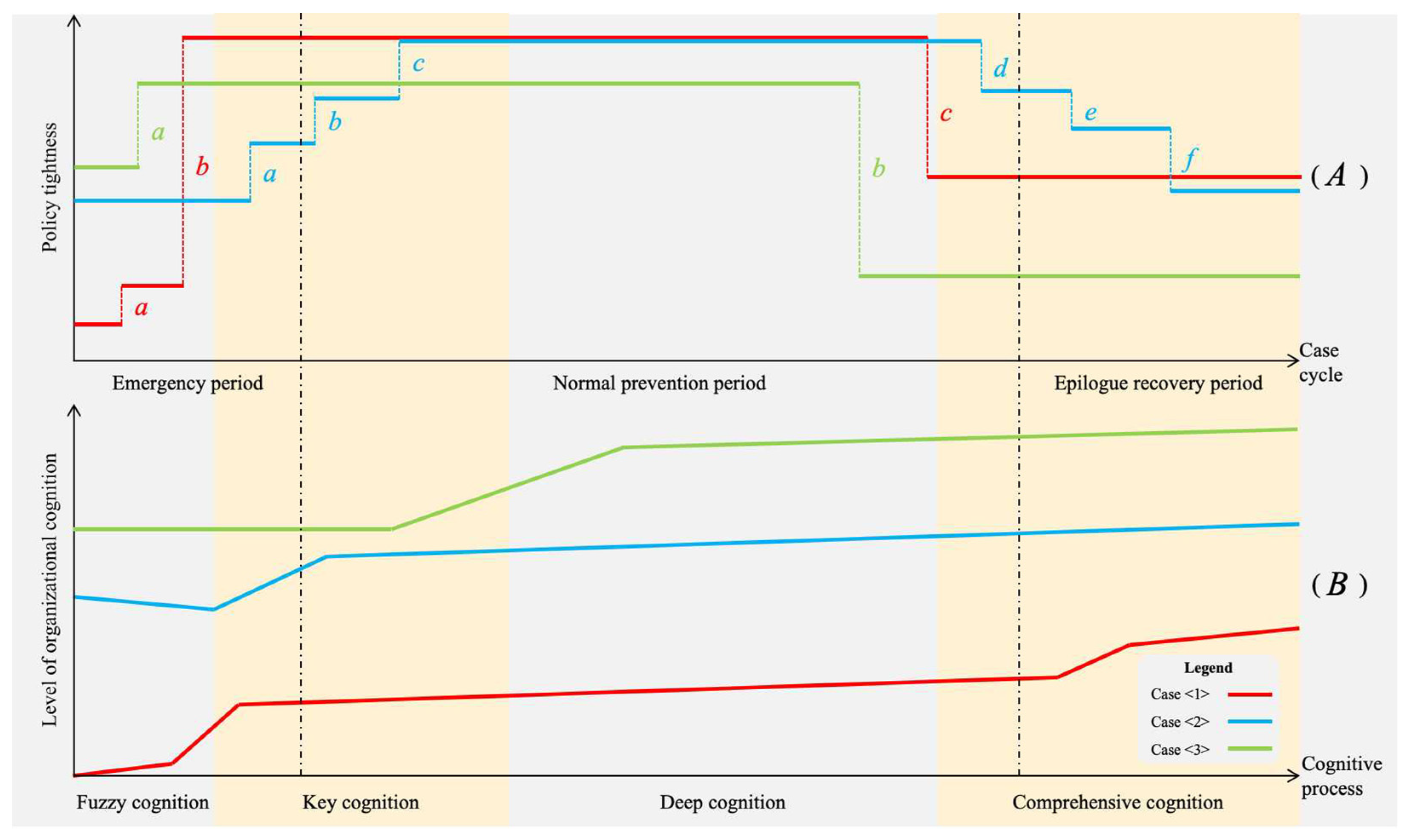

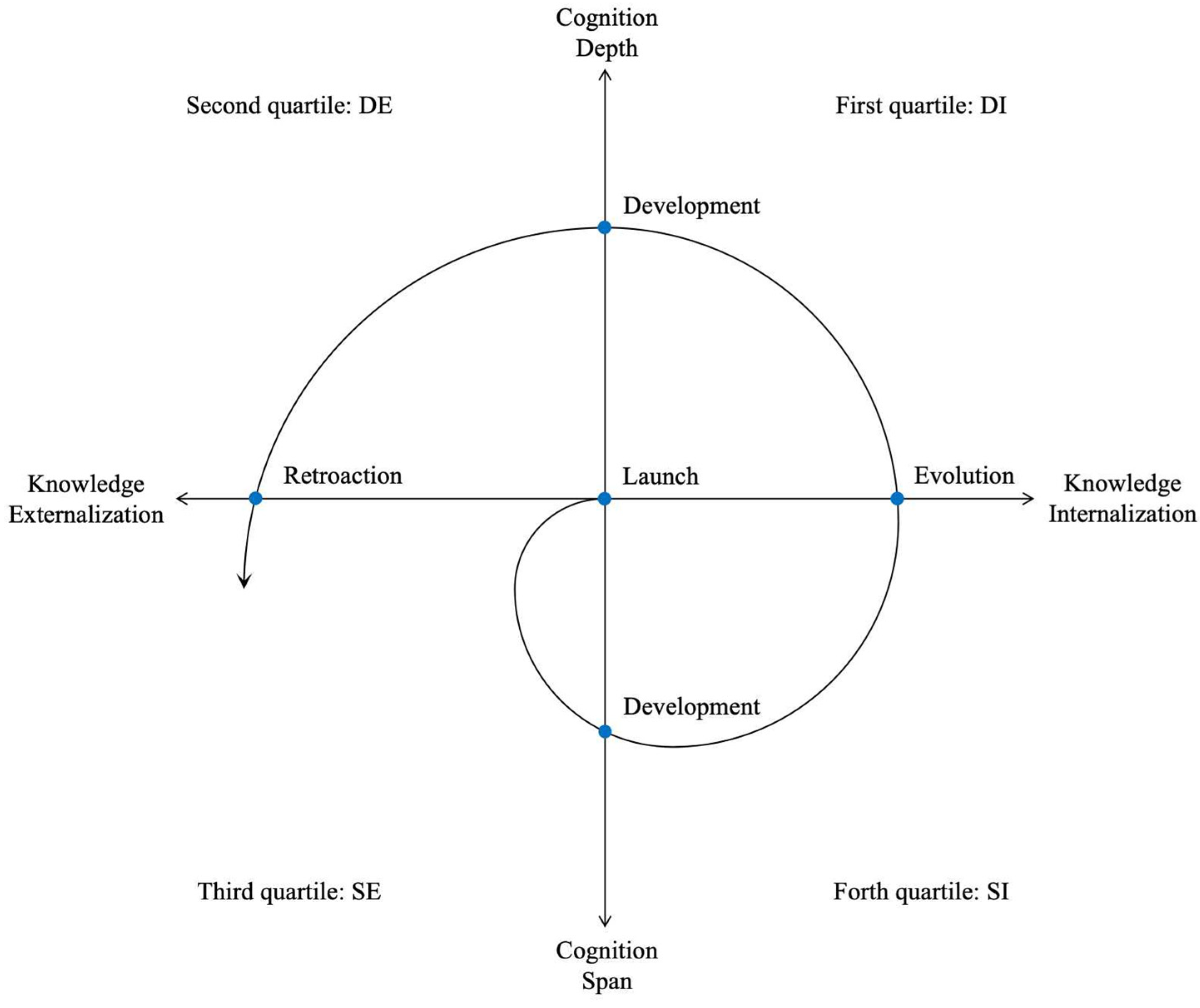
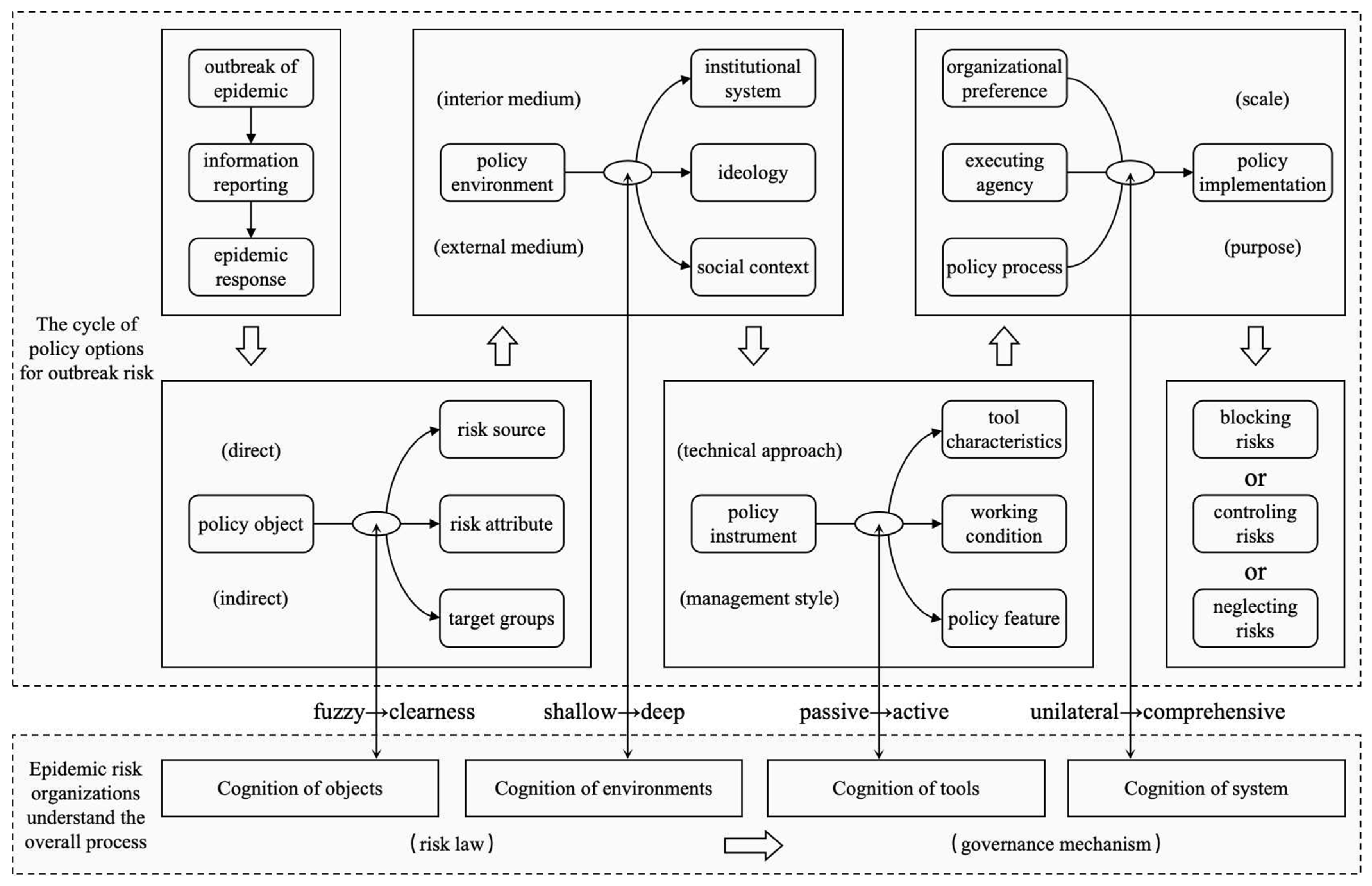
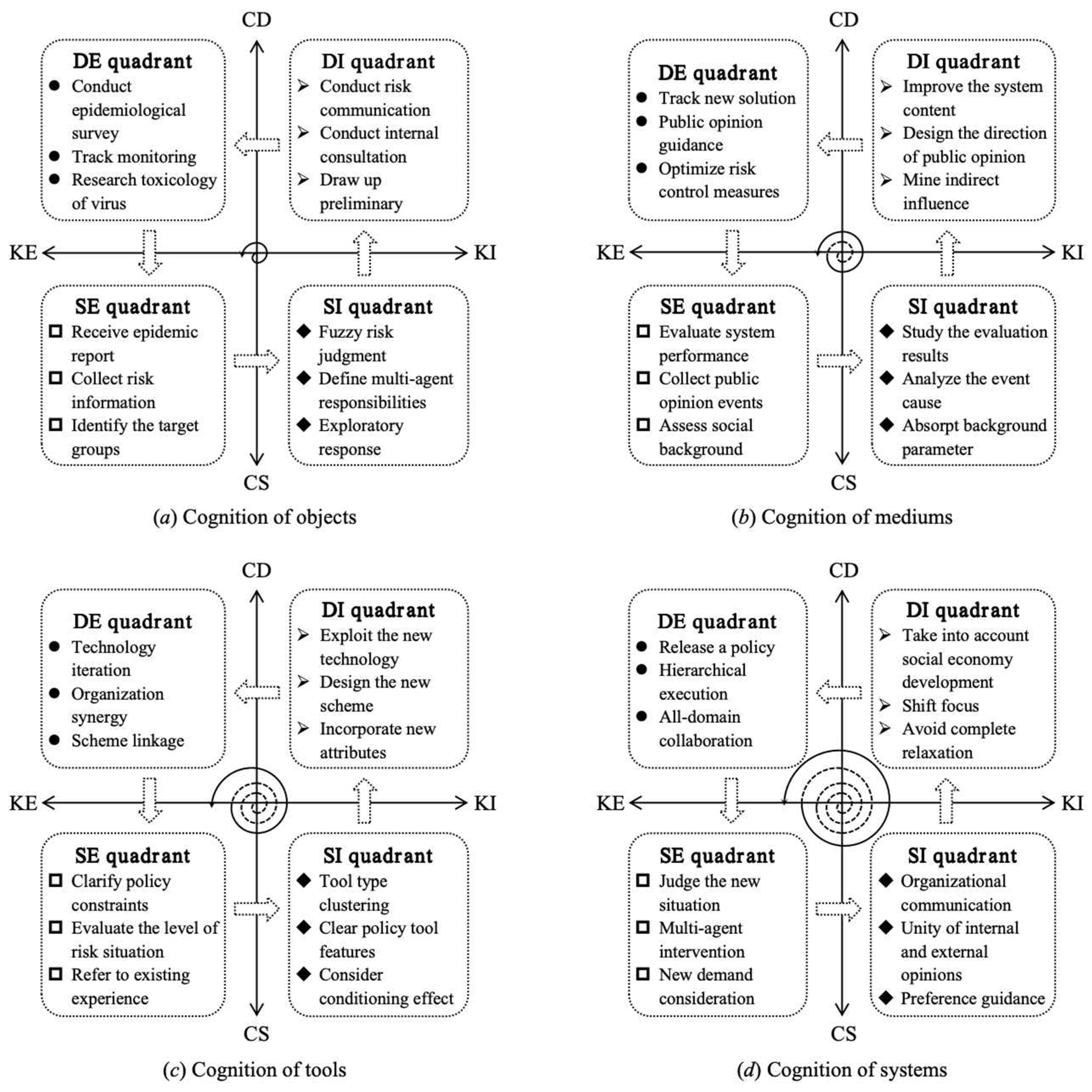
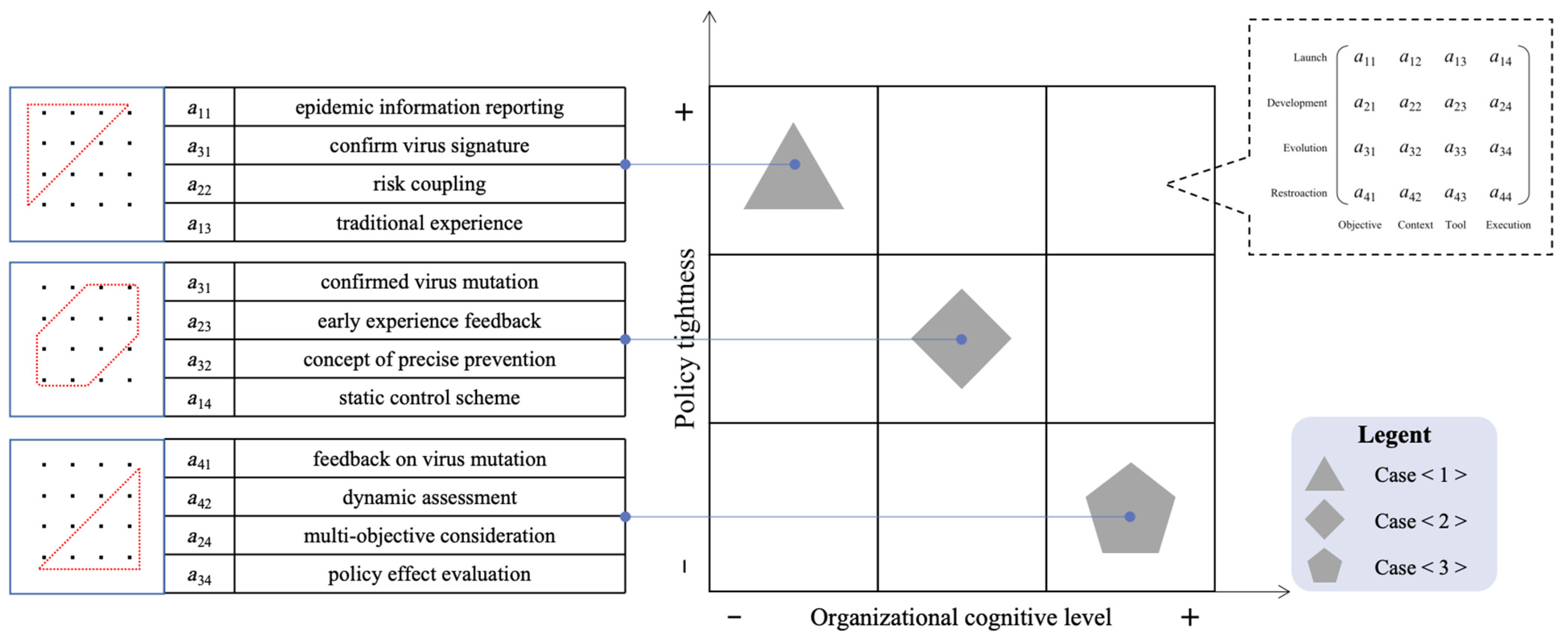
| Category | Viewpoint | Author |
|---|---|---|
| Cognitive Subject | The main body of organizational cognition presents the trend of diversification. | Maule, 2004 [21] |
| Senior managers play the role of cognitive leaders in organizational cognition. | Matysiak etc., 2018 [22] | |
| The demographic characteristics and power structure of the subject affect organizational cognition. | Mol etc., 2015 [23] | |
| Cognitive Process | Organizational cognition is the process of the member’s implicit mind from generation to explicit. | Hartmann etc., 2006 [24] |
| Sufficient communication plays a positive role in the formation and transformation of shared emotions. | Muthusamy, 2019 [25] | |
| Member-distributed cognition plays a special role in the formation of organizational cognition. | Jensen etc., 2022 [26] | |
| Organizational Culture | The interaction of value orientation and emotional attitude determines the direction of organizational cognition. | Eveland etc., 2013 [27] |
| Diverse organizational cultures have different promoting effects on organizational cognitive motivation. | Duan etc., 2022 [28] | |
| The culture can be manifested as organizational learning, shared mind, interactive memory, and psychological climate. | Islam, 2015 [29] | |
| Environmental Impact | The intensity of external risk can significantly stimulate the initiative of organizational cognition. | Gupta etc., 2012 [30] |
| Organizational cognition should actively respond to the changes in the dynamic external environment. | Maran etc., 2022 [31] | |
| Historical experience is conducive to the formation of good new cognition in an abnormal environment. | Nayak etc., 2020 [32] |
| Code | Case <1> | Case <2> | Case <3> |
|---|---|---|---|
| Name | Wuhan epidemic | Shanghai epidemic | Outbreak in winter 2022 |
| Synopsis | In December 2019, Wuhan erupted with an unknown pneumonia. The epidemic lasted for over 3 months. By 8 April 2020, 50,008 people had been infected and 2574 had died. | The outbreak of COVID-19 in Shanghai began in March 2022 and lasted for about three months. As of 18 May, 57,260 people had been infected and 276 had died. | In November 2022, the number of asymptomatic patients soared, and the epidemic peak lasted over a month, with 136,689 infections and 15 deaths as of 25 December. |
| Virus intensity | strong | Middle | weak |
| Epidemic feature | new outbreak | virus variation | environmental change |
| Stage position | initial | middle to late | terminal |
| Major policy | Lockdown | Static Management | Class as B and Treat as B |
| Area | Wuhan City | Shanghai City | Chinese mainland |
| Mode | administrative order | contingency plan | System improvement |
| Response | 1/2 week | 3 weeks | 4 weeks |
| Cognitive process | ambiguous→distinct | superficial→essential | focused→general |
| Policy scale | tightest | tighter | looser |
| Policy feature | moving administrative enforcing | hierarchical classification | shift of focus |
| Policy function | epidemic risk prevention | epidemic risk prevention ensuring regional stability | epidemic risk prevention regional development socioeconomic recovery |
| Node | Case <1> | Case <2> | Case <3> | |
|---|---|---|---|---|
| Launch | Interior | Monitoring and reporting mechanism | Implementing contingency plan | Concept of precise epidemic prevention |
| Exterior | Preventing unknown pneumonia | Guarding against imported risks | Response to multiple outbreaks | |
| Development | Breadth | Expanding epidemic information channels | Multiple impacts of prevention policies | Socioeconomic forecasting |
| Depth | Mining virus signatures | Finding virus mutation | Finding the decrease in virus intensity | |
| Evolution | Technique | Developing health code | Applying AI technology | Promote nucleic acid self-testing |
| Regime | Revising prevention and control plan | Implementing global static control | Executing Class as B and Treat as B | |
| Retroaction | Experience | Resource integration and rapid response | Risk prevention by classification | Adjusting the policy tightness |
| Lesson | Single communication Channel | Incomprehensive initial cognition | Inadequate supporting measures | |
| Node | Policy Object | Policy Context | Policy Tool | Policy Execution |
|---|---|---|---|---|
| Launch | epidemic report | incentive and constraint | traditional tool selection | execution plan validation |
| Development | experience evaluation mode | category expansion | adaptive improvement | multiple choices |
| Evolution | Substantive characteristics | multi-objective interaction | new tool development | institutional formation |
| Retroaction | cognitive praxis | environment assessment | tool application | systematic execution |
Disclaimer/Publisher’s Note: The statements, opinions and data contained in all publications are solely those of the individual author(s) and contributor(s) and not of MDPI and/or the editor(s). MDPI and/or the editor(s) disclaim responsibility for any injury to people or property resulting from any ideas, methods, instructions or products referred to in the content. |
© 2024 by the authors. Licensee MDPI, Basel, Switzerland. This article is an open access article distributed under the terms and conditions of the Creative Commons Attribution (CC BY) license (https://creativecommons.org/licenses/by/4.0/).
Share and Cite
Fan, C.; Zhuang, Y.; Qian, Y. Tight or Loose: Analysis of the Organization Cognition Process of Epidemic Risk and Policy Selection. Sustainability 2024, 16, 3949. https://doi.org/10.3390/su16103949
Fan C, Zhuang Y, Qian Y. Tight or Loose: Analysis of the Organization Cognition Process of Epidemic Risk and Policy Selection. Sustainability. 2024; 16(10):3949. https://doi.org/10.3390/su16103949
Chicago/Turabian StyleFan, Chao, Yue Zhuang, and Yangyang Qian. 2024. "Tight or Loose: Analysis of the Organization Cognition Process of Epidemic Risk and Policy Selection" Sustainability 16, no. 10: 3949. https://doi.org/10.3390/su16103949
APA StyleFan, C., Zhuang, Y., & Qian, Y. (2024). Tight or Loose: Analysis of the Organization Cognition Process of Epidemic Risk and Policy Selection. Sustainability, 16(10), 3949. https://doi.org/10.3390/su16103949





